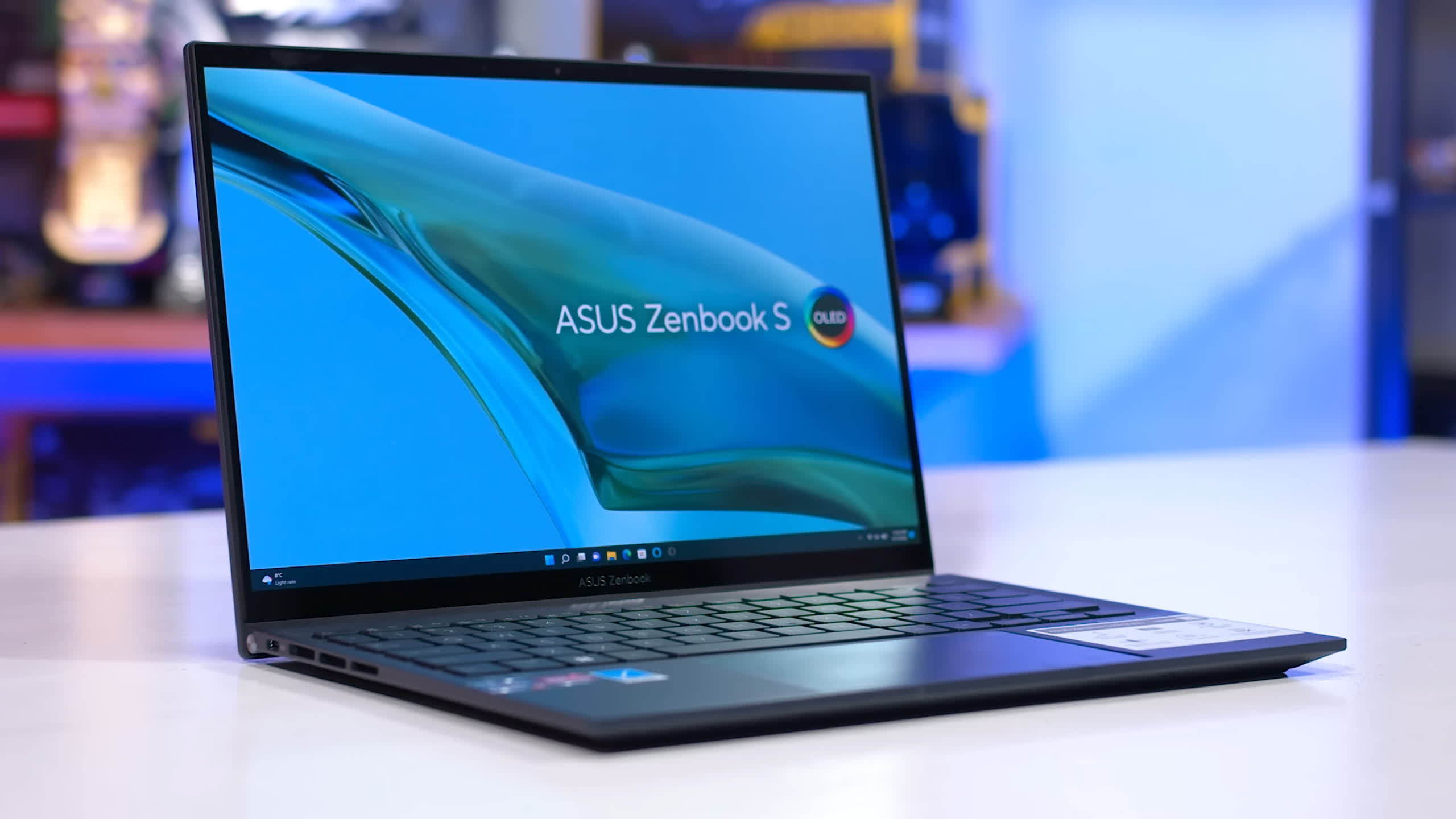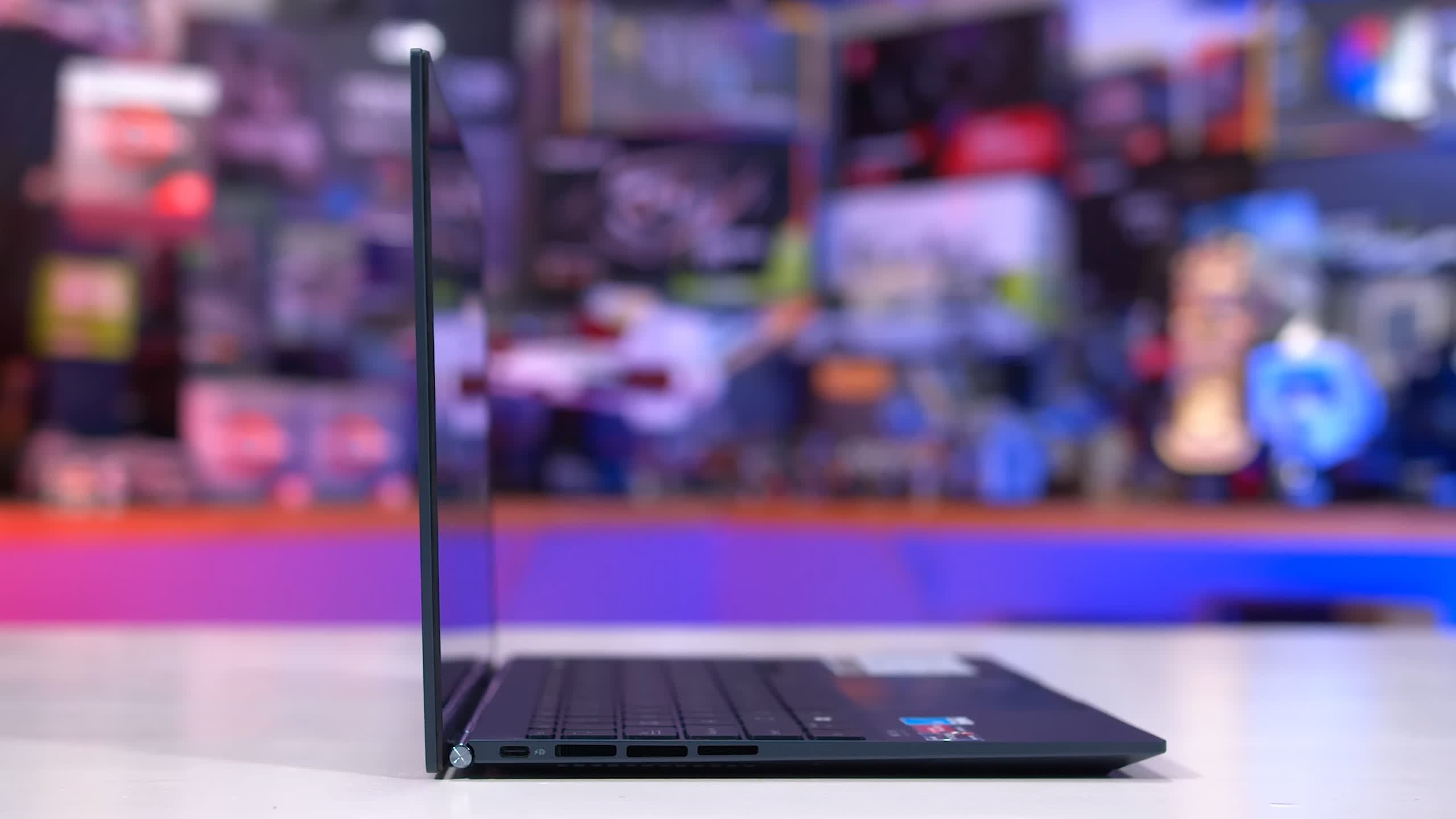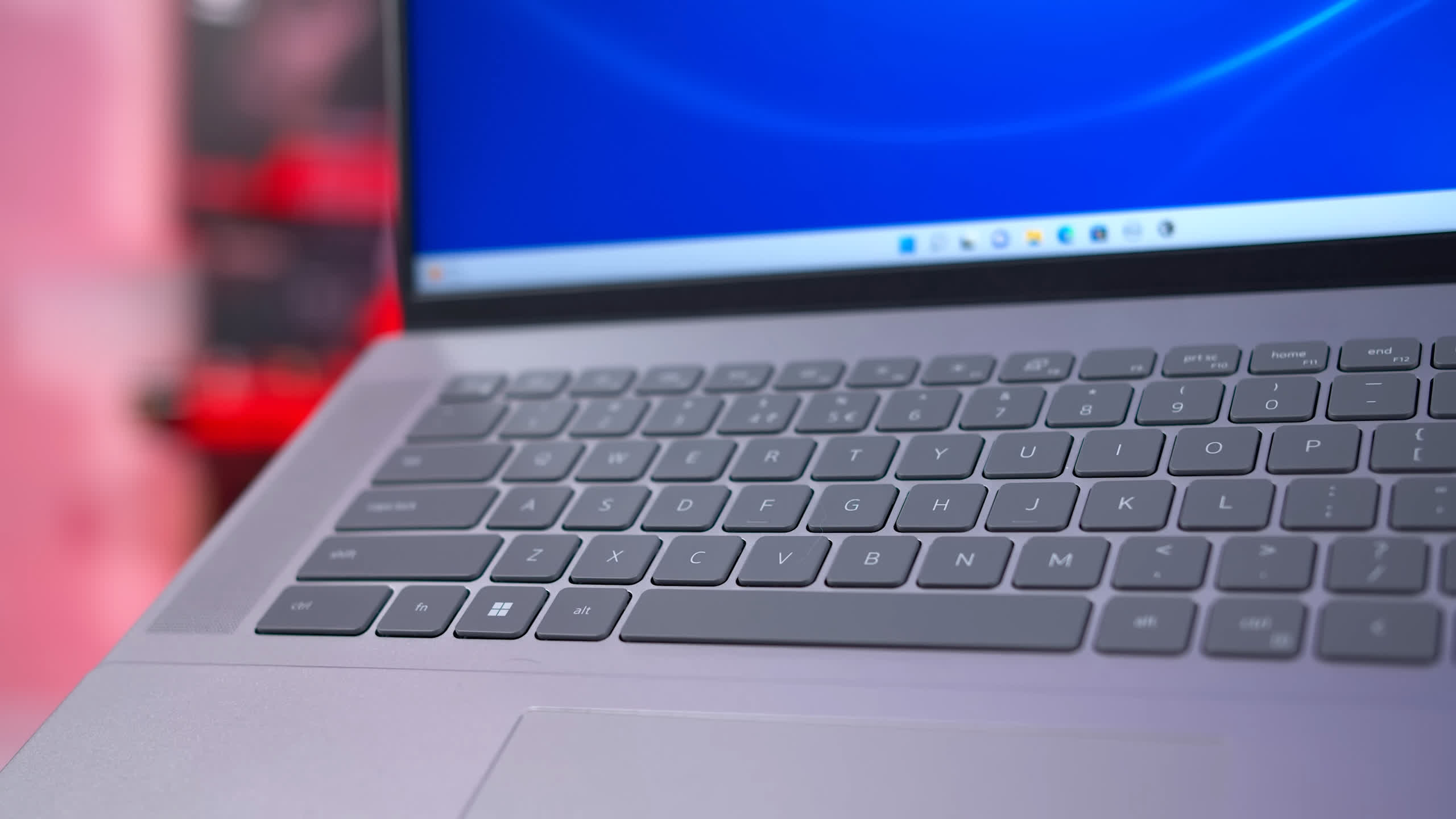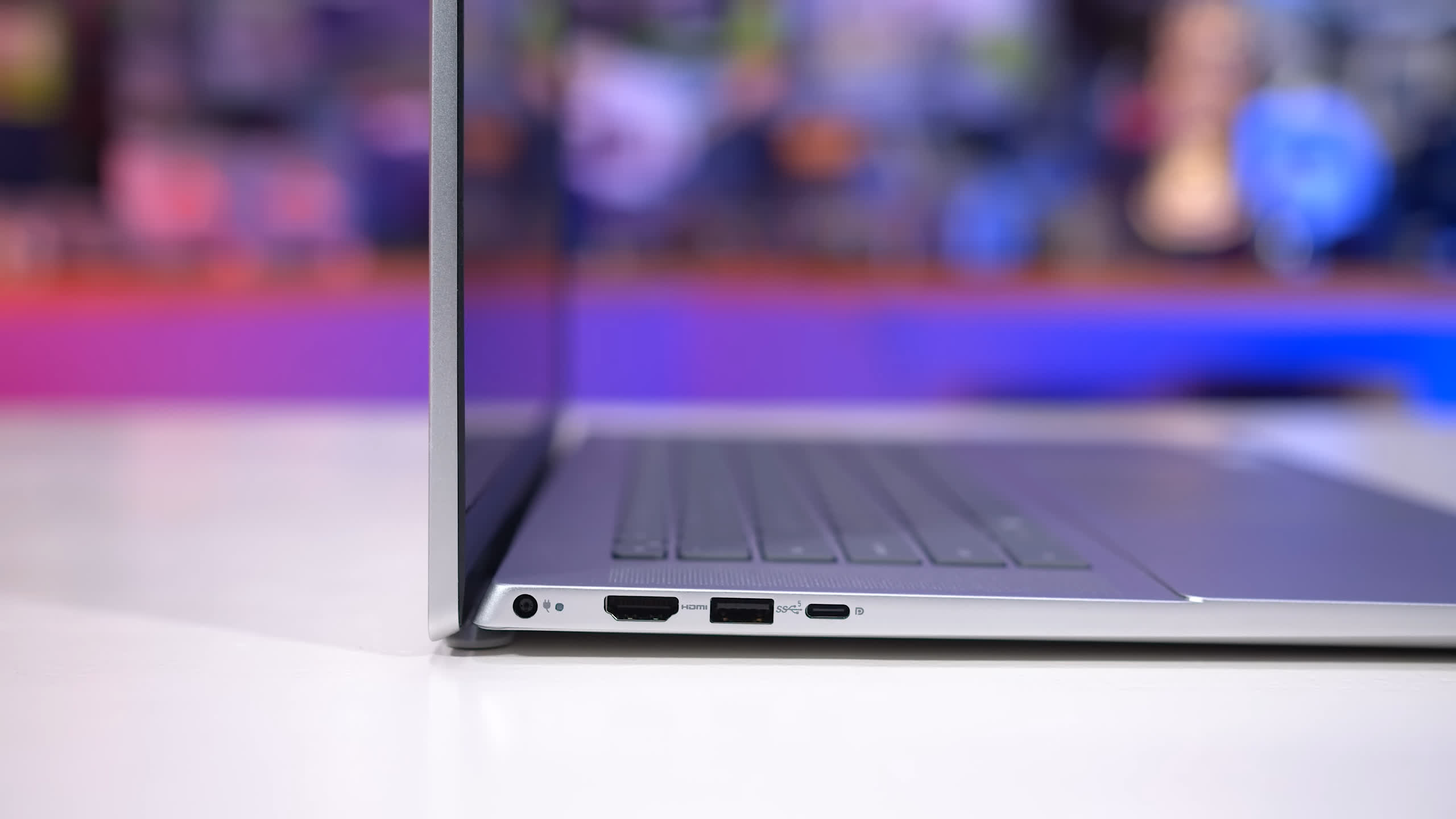The Ryzen 7 6800U is AMD’s latest and greatest chip from their new Zen 3+ line for ultraportables, while the Intel Core i7-1260P is headlining a number of today’s powerful thin and light systems based on the Alder Lake architecture.
Both of these CPUs are capable of pushing package power up in excess of 25W, which is where most of today’s performance-oriented ultraportables are sitting. In fact, the default TDP for the Core i7-1260P is 28W, new for this generation is the P-series designation, while the 6800U is designed to run at a range of TDPs between 15 and 28W.
In terms of specifications, the Ryzen 7 6800U is an 8-core, 16-thread processor using Zen 3+ cores. It has a maximum boost clock of 4.7 GHz and a base of 2.7 GHz, along with 16 MB of L3 cache, and a 12 compute unit RDNA2 GPU running up to 2.2 GHz, new for this generation.
The latest platform features like DDR5 memory and USB4 are supported, and the whole thing is built on TSMC’s N6 node.

On the Intel side, the Core i7-1260P is a hybrid CPU combining a 4-core, 8-thread P core layout with an 8-core, 8-thread E core. The P cores clock up to 4.7 GHz from a 2.1 GHz base, while the E cores hit 3.4 GHz from a 1.5 GHz base. Then on the GPU side we get 96 execution units of Xe graphics running up to 1.4 GHz, plus 18 MB of L3 cache. Intel supports both DDR4 and DDR5 memory, and the node used here is Intel 7.

The new Asus ZenBook S 13 OLED is our test system for the 6800U, a super neat thin and light convertible notebook with a gorgeous 13-inch 2880 x 1800 OLED display. It’s just a kilogram heavy and packs a 67 Wh battery to help deliver strong battery life, which we’ll be testing later.
Complementing the Ryzen CPU is 16GB of LPDDR5-6400 memory and a 1TB SSD from Samsung.

Finding an Intel Alder Lake P-series laptop this generation was rather difficult, as like with AMD systems, availability has been quite limited. The i7-1260P isn’t the fastest part Intel are offering, but it was the fastest we could get to make this review, and seems to be deployed in more laptops than the 1280P at this time.
The Dell Inspiron 16 5620 is our test system for the Intel processor, which allows the CPU to run in the 25W to 28W power class like the Asus system with Ryzen. This gives us a baseline apples to apples comparison, though this machine only uses 16GB of DDR4-3200 memory, but again, it’s the best we could find right now for testing.

What you’ll see in the charts that follow is a comparison to other laptop CPUs that we’ve tested, all tested in as close to the same power configuration as possible. We have the 6800U running at a 25W long term power limit, and the 1260P at a 28W long term limit, which in this instance means both systems were running in their fastest available performance modes.
We’ll be working through some productivity benchmarks, compute benchmarks, gaming performance on the iGPU and battery performance, so plenty to get through, starting with Cinebench, as usual…
Application Benchmarks
In Cinebench, the Ryzen 7 6800U is the fastest ultraportable class processor that we’ve tested so far, beating Intel’s 1260P by 9 percent – it’d certainly be interesting to see how the 1280P stacks up here. However the gains compared to its predecessor are relatively small at just a 4 percent performance increase, which is similar to what we saw testing the 35W HS series.
The Zen 3+ chips aren’t all that different from Zen 3 that was used in the 5800U and so there isn’t much headroom to improve performance. On the other hand, the 1260P is significantly faster than Intel’s previous-gen, the Core i7-1165G7, a huge 71 percent performance uplift allows Intel to close the gap, and surely, the much better naming scheme helped here, too.


As we saw earlier in the year when comparing more gaming focused CPUs, Alder Lake holds a decent performance advantage over Zen 3+ for single threading. The 1260P is 18 percent faster than the 6800U, and 13 percent faster than Intel’s last-generation part. The 6800U doesn’t gain much over the 5800U in this workload, as the newer Zen 3+ model receives only a 7 percent frequency bump.

In Handbrake, Ryzen continues its dominance over Intel in this benchmark. The 6800U was 22 percent faster than the 1260P, and actually ended up beating Apple’s M1 Pro, which is a decent result given the power class difference.
However, the performance uplift over the 5800U is minimal, Intel are certainly delivering a much larger gain gen-on-gen, so those with an 11th-gen processor or older should definitely consider an upgrade.

For code compilation on the go, the Ryzen 7 6800U and Core i7-1260P are neck and neck to a surprising degree. Based on these numbers I would think the 1280P would be the fastest 28W choice, and it’s disappointing to see no major improvement for AMD over the 5800U. Meanwhile, Intel are getting a massive 65 percent performance uplift, as they’ve finally shifted away from a basic quad-core design, which are no longer suitable for high-end mobile CPUs.

Our Microsoft Excel benchmark is faster on the 6800U than the 1260P, though these results will be affected to some degree by LPDDR5 vs DDR4 in our test systems. Excel is quite memory and cache sensitive, so it’s one of the few benchmarks where the newer Zen 3+ design from AMD is notably faster than the prior generation — here it’s 16 percent faster. Intel also benefits with a 45 percent performance gain, but in this instance this doesn’t see them take the lead.

Intel is the clear winner in the broader PCMark 10 Applications workload, which tests the Microsoft Office suite. There was no performance gain for the 6800U vs 5800U, while the 1260P was able to outperform the 1165G7 by 9 percent. This gave Intel an overall 12 percent performance lead. Not a massive result, but large enough that it may matter for some buyers.


7-Zip compression didn’t see substantial performance gains for either platform. Meanwhile for decompression, it’s only the Intel side that gained gen-on-gen: the 1260P is 50 percent faster than the 1165G7. Unfortunately for Intel, AMD was so far ahead before that despite this big uplift, the 6800U continues to hold a 29 percent performance advantage for decompression.

Intel mobile processors continue to lead in Adobe Photoshop, though the gains for both generations are not very substantial, or in the case of AMD, non existent. The 1260P is 7 percent faster than the 6800U here.

In Adobe Premiere, the better choice this generation is the Ryzen 7 6800U thanks to a sizable jump in GPU performance. The 1260P is faster than prior Intel CPUs in sub-scores like Export, but suffers from not boosting its GPU performance all that much, especially when paired with DDR4 memory.
We think the score would be better had LPDDR5 memory been used to match the AMD laptop, but the raw GPU differences probably would still play a part.

For AI accelerated workloads like Gigapixel AI, Intel processors are the way to go due to their AI acceleration hardware, which this generation of Zen does not include. The 1260P performs well without a discrete GPU, and as we saw last generation, adding a low power Nvidia GPU actually hurts performance unless you disable it. The 6800U doesn’t perform horribly without AI acceleration, still beating the 1165G7, but performance is 24 percent slower than the 1260P.

The tables are flipped for the Agisoft Metashape photogrammetry benchmark. This workload is mostly GPU bound on ultraportable-class processors, and we see a decent 40 percent performance lead to the 6800U here over the 1260P. It actually manages to beat the 12900HK despite the much lower level of power usage.
Gaming Benchmarks
For integrated graphics gaming, the clear winner is AMD and the Ryzen 7 6800U. In Gears 5 running at 1080p using medium settings, the 6800U is significantly faster than other processors, managing to deliver 87% of the performance of the Ryzen 9 6900HS.
The Core i7-1260P seems to struggle with DDR4 memory as if this chip was designed to be paired with DDR5 or LPDDR5 instead. But even if it did have faster DDR5 memory, the 6800U would likely still beat it, as the 6800U was 18 percent faster than even the Core i7-12700H running at 45W with its GPU configuration being identical to the 1260P.


In Resident Evil 2 the 6800U also performed very well, smashing the 1260P with DDR4 memory and outperforming Intel’s H-series parts with DDR5 memory by 16 percent despite the gulf in power consumption. While this class of ultraportable is still a way off an entry-level gaming system with an RTX 3050, the sorts of performance numbers put up here are playable.

For a game that’s demanding on both the CPU and GPU, the 6800U holds up well in Age of Empires IV running using medium settings at 1080p. Once again it’s faster than Intel H-series parts which present an ideal case for Alder Lake’s Xe integrated graphics, and if you turn down the settings slightly the experience is very playable for this sort of title.

In Rainbow Six Siege, the 6800U is an excellent iGPU option and the performance is mighty impressive from a 13-inch thin and light notebook. Not only do we see 72 percent better performance than last year’s 5800U, we also see a 21 percent lead on Intel’s best Alder Lake iGPU option.

Lastly, in Watch Dogs Legion, the 6800U is 28 percent faster at integrated graphics gaming than the 12900HK playing at 1080p using Low settings. Yeah, the frame rate isn’t amazing, but the average is over 30 FPS which you could probably suffer through at a pinch depending on how desperate you are to play this game.
But given this is a relatively modern title, it does suggest that quite a number of games will work on the 6800U with low settings at a native 1080p, or near native using upscaling tech like FSR.
Battery Life
By popular demand, we are working on a suite of battery life tests for laptops and we’re just showing an early teaser for this review, especially as we didn’t have a ton of time to complete all the testing.
We’re using the PCMark 10 Applications battery life benchmark, running on both systems using the “best efficiency” power mode in Windows 11 with Wi-Fi enabled and 200 nits of display brightness.

The raw numbers from this test show the ZenBook S 13 OLED as having much better battery life than the Inspiron 16 5620. However, the ZenBook despite being a smaller design actually has a larger battery. When we normalize the results to account for the differences in battery size, the Ryzen powered machine ended up with a 13 percent longer battery life per Wh in this test which mixes light productivity work with idle time.
What We Learned
Overall it’s been an interesting comparison between the AMD Ryzen 7 6800U and Intel Core i7-1260P, as both parts end up trading blows depending on the workload, and each have their own strengths and weaknesses.
There have been times in the laptop market where one CPU vendor has dominated across the board, but in 2022 that isn’t the case, so how you use your portable laptop will have an influence on which chip makes the most sense — or conversely, you can pick and choose not solely based on CPU but on laptop brand/model and other features like display quality.

In terms of the Ryzen 7 6800U, CPU performance hasn’t increased substantially comparing this generation to the previous: Zen 3+ doesn’t offer much outside of a small frequency uplift. The upgrade to DDR5 memory may have a benefit depending on the workload, but most of the time it doesn’t.
The real killer feature in the new Ryzen is the much faster RDNA2 integrated graphics, which brings over a 50% performance boost compared to Ryzen 5000 and really makes iGPU gaming possible even in some modern games, albeit using low settings. If you plan to leverage the GPU often, this could make this latest generation worth upgrading to, but if not then there’s not much on it.

The Core i7-1260P is a bit of a different beast and does offer a massive performance boost over its predecessor (the Core i7-1165G7) in CPU performance. Multi-thread is up over 50% compared to Tiger Lake and we’re getting a double digit single-thread gains as well.
This obliteration of Intel’s 11th-gen U series offering makes buying an 11th-gen laptop a really bad idea. You’re definitely better off waiting for 12th-gen if you want to buy Intel and the laptop you are looking at isn’t available yet. On the other hand, GPU performance gains are minimal, and as we saw from our Dell laptop, DDR4 memory is not a good pairing if you want to use the iGPU for gaming.

Picking a CPU for Your Next Ultraportable
So which of these processors is worth getting in your next ultraportable system?
For CPU performance, it depends on what you’re doing. Despite big gains on the Intel side, the 6800U is typically the faster part for multi-thread workloads, so if you have heavier applications you want to run, Ryzen is going to suit your needs better. However, the 1260P has stronger single-thread, and that does help in some typical use cases for a portable laptop, like Microsoft Office or Photoshop.
For anything GPU related, whether that’s gaming or GPU accelerated productivity, it’s a slam dunk win for Ryzen. The new RDNA2 iGPU is very impressive, beating the best Alder Lake Xe GPU offering in their 45W H-series parts, despite only running inside of 25W package power.
As for battery life and efficiency, it’s hard to pass judgment from a platform perspective as we’ve only tested two systems, and they’re pretty different. However lots of people have been wanting us to evaluate battery life, and the limited result we measured showed AMD a bit ahead. The 6800U is also superior in performance per watt, so the actual performance you get for a given battery drain will be higher with Ryzen, though real world results are typically influenced heavily by how OEMs configure their system.

Aside from the fundamental aspects to these platforms, one of the biggest challenges at the moment is just getting them into the hands of prospective buyers. AMD has struggled for a while now to get their CPUs into a wide range of ultraportables, and while the tide is turning on that slowly, even right now in a period of poor availability, Intel Alder Lake systems are generally easier to find.
Finally, talking about the exact systems we tested, the Asus ZenBook S 13 OLED is an excellent laptop, the combination of high performance and a beautiful display is basically what I’m after in a laptop of this type in 2022. The Dell Inspiron 16 5620 is a reasonable laptop with good performance and a nice large display, but it’s more of a mid-range option. Dell opting for DDR4 memory instead of DDR5, for example, is going to limit performance to some degree.
Shopping Shortcuts
- Asus ZenBook S 13 OLED on Asus
- Dell Inspiron 16 5620 on Dell
- Ryzen 7 6800U Laptops on Amazon
- Intel Core i7 Alder Lake Laptops on Amazon
- GeForce RTX 3080 Laptops on Amazon
- GeForce RTX 3070 Laptops on on Amazon
- Ryzen 5 5800U Laptops on Amazon

